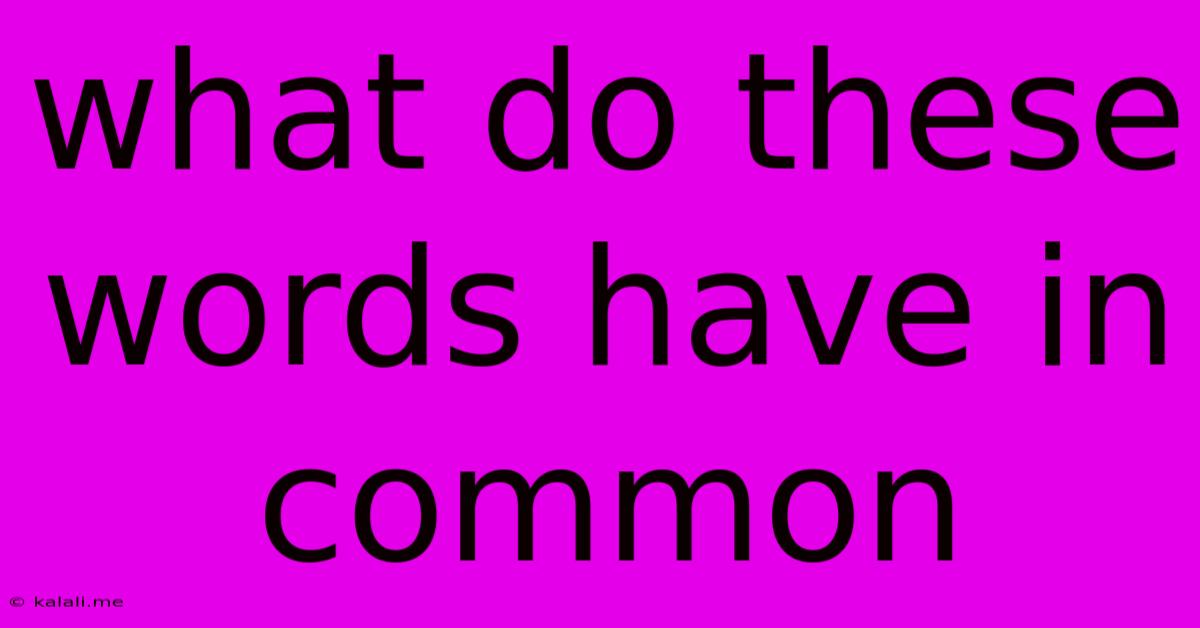What Do These Words Have In Common
Kalali
Jun 09, 2025 · 3 min read

Table of Contents
What Do These Words Have in Common? Unlocking the Power of Semantic Relationships
This article explores the fascinating world of semantic relationships between words. We'll delve into how seemingly disparate terms can be linked through shared meanings, contexts, and underlying concepts. Understanding these relationships is crucial not only for language comprehension but also for effective SEO and content creation. Learning to identify these connections will help you craft more engaging and search-engine-friendly content.
What are Semantic Relationships?
Before we dive into examples, let's define what we mean by "semantic relationships." Simply put, it's the connection in meaning between words. This connection can manifest in various ways, including:
- Synonyms: Words with similar meanings (e.g., happy, joyful, delighted).
- Antonyms: Words with opposite meanings (e.g., hot, cold; big, small).
- Hyponyms/Hypernyms: Hyponyms are specific examples of a broader category (e.g., "rose" is a hyponym of "flower"), while hypernyms are the broader categories themselves (e.g., "flower" is a hypernymer of "rose").
- Meronyms/Holonyms: Meronyms are parts of a whole (e.g., "wheel" is a meronym of "car"), while holonyms are the whole entity (e.g., "car" is a holonym of "wheel").
- Co-hyponyms: Words that share the same hypernym (e.g., "rose," "tulip," and "daisy" are co-hyponyms because they are all types of "flowers").
Examples of Semantic Relationships and Their Application in Writing
Let's look at some practical examples to illustrate how understanding semantic relationships can improve your writing:
Example 1: "Sun," "Solar," "Radiant," "Heat," "Brightness"
These words, while not direct synonyms, are semantically related because they all relate to the sun's properties and effects. Understanding this allows for richer writing, avoiding repetition and building a more comprehensive picture for the reader. In SEO, using these related terms naturally within your content helps broaden your keyword reach.
Example 2: "Fast," "Quick," "Rapid," "Swift," "Velocity"
These terms all describe speed. Using a variety of these words instead of repeating "fast" repeatedly creates a more dynamic and engaging piece of writing. From an SEO perspective, this helps your content rank for variations of the core keyword, "speed."
Example 3: "Apple," "Fruit," "Orchard," "Tree," "Harvest"
This group shows the hypernym/hyponym and meronym/holonym relationships. "Apple" is a hyponym of "fruit," and "fruit" is its hypernym. "Apple" is also a meronym of "orchard," and "orchard" is a holonym of "apple". The semantic connections here can build a richer context within your writing about apples or orchards.
Improving SEO Through Semantic Relationships
Understanding semantic relationships is vital for effective SEO. Search engines use sophisticated algorithms to understand the meaning and context of words, not just individual keywords. By incorporating semantically related terms into your content, you create a more comprehensive and contextually relevant piece, which can improve your search engine rankings. This is because search engines understand the relationships between words, making your content more likely to appear for related search queries.
Conclusion
Mastering semantic relationships significantly elevates your writing and SEO strategy. By understanding the nuances of word connections, you can create more engaging, contextually rich content that resonates with both readers and search engines. This allows for a more natural and effective keyword strategy, leading to improved visibility and stronger online presence.
Latest Posts
Latest Posts
-
How Many Feet Are In 50 Yards
Jul 01, 2025
-
How Many Cups Are In 3 Quarts
Jul 01, 2025
-
Four Letter Word With Second Letter A
Jul 01, 2025
-
How Many 1 8 Cups Are In 2 3 Cup
Jul 01, 2025
-
How Many Slices Of Turkey In 2 Oz
Jul 01, 2025
Related Post
Thank you for visiting our website which covers about What Do These Words Have In Common . We hope the information provided has been useful to you. Feel free to contact us if you have any questions or need further assistance. See you next time and don't miss to bookmark.